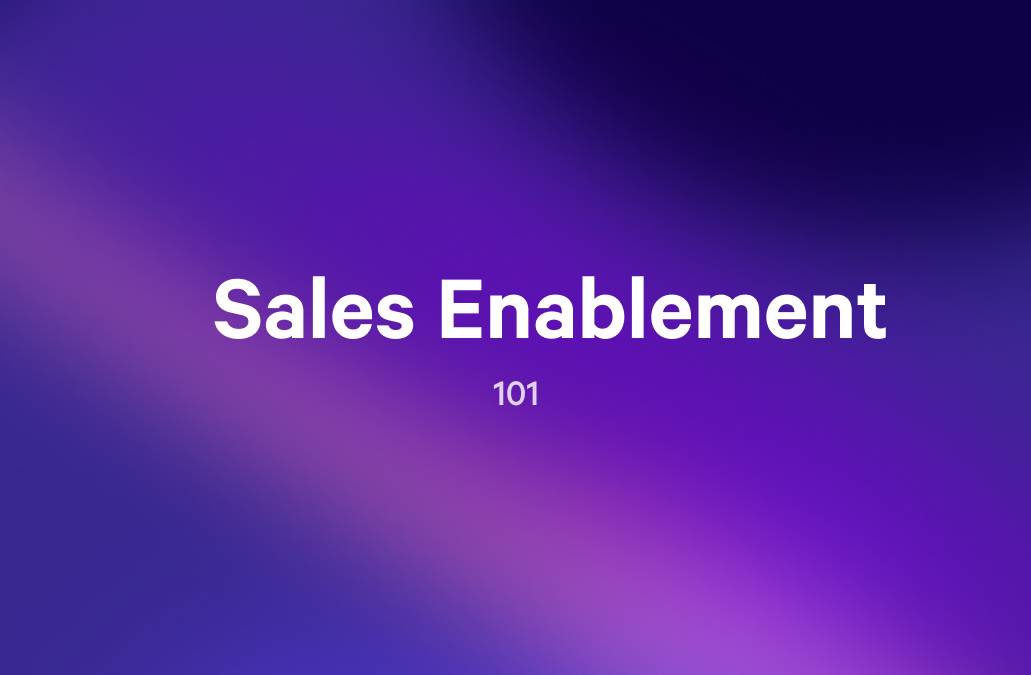Sales reps are drowning in content. Case studies, battlecards, one-pagers, pitch decks, ROI calculators, proposal templates, “fun fact” PDFs that marketing insists you need. Without a good Sales Content Management (SCM) system, your team spends half their day searching for the right asset… only to send the wrong version anyway.
Sales Content Management Software is your guy.
But not all SCM tools are created equal. Some are lean and scrappy, others are enterprise behemoths. Some are content libraries, others double as training platforms. And one (spoiler alert) turns boring PDFs into interactive, trackable experiences that basically sell themselves.
Here’s our definitive list of the 11 best sales content management tools in 2025:
- Qwilr
- Seismic
- Highspot
- Showpad
- ClearSlide
- Paperflite
- DocSend
- Guru
- Bloomfire
- Bigtincan
- Mediafly
What is a sales content management system?
Sales content management (SCM) software is a platform designed to help sales and marketing teams organize, distribute, and track customer-facing materials such as proposals, pitch decks, case studies, one-pagers, and training resources. Instead of files getting lost in endless email threads or buried in Google Drive folders, SCM provides a centralized hub where reps can instantly find the right piece of content at the right moment.
Crucially, SCM isn’t just about storage! The most effective platforms add intelligence on top of organization, offering powerful search and tagging functions so content is easy to locate, version control to eliminate outdated decks floating around, and analytics that reveal which assets are truly influencing deals. Many also integrate directly with CRMs and email platforms, and increasingly use AI to recommend the “next best” asset for each selling scenario (no shocker there).
In short, it moves teams from a messy filing cabinet to a connected content engine.
Why is SCM essential for sales teams?
Reps spend far too much time searching for content when they should be selling. Studies suggest sellers can lose up to 30% of their week just hunting for or recreating collateral—a massive drain on sales productivity, consistency, and ultimately revenue. SCM software eliminates that inefficiency by giving teams one trusted source of truth, where the right content is not only stored but also surfaced when it’s needed most.
And the benefits go beyond time savings. With marketing-approved templates, sales reps present consistent branding and messaging across every touchpoint. Leaders gain data-driven insights into which assets resonate with prospects, allowing them to double down on what works instead of relying on gut feel. And onboarding speeds up dramatically when new hires can access clear playbooks, training materials, and proven sales content from day one.
At its core, SCM ensures that the right content reaches the right hands at the right time—turning sales conversations into revenue-generating moments.
- Reps sell more efficiently, with less wasted time.
- Marketing gains visibility and control over how content performs in the field.
Sales content management by the numbers
Sales content management (SCM) isn't just a nice-to-have; it's a strategic lever that directly impacts revenue. Here are some compelling stats from G2 Learn Hub to consider:
- Organizations with a dedicated sales enablement strategy achieve a 49% higher win rate on forecasted deals.
- Implementing effective sales enablement tools can reduce onboarding time for new sales reps by 40–50%.
- Companies using a unified enablement platform are 80% more likely to increase their win rates.
- Half of all prospect engagement is generated by just 10% of sales enablement content.
The top sales management tools for your team to excel
1. Qwilr – Best for proposal management

If you think SCM is just a glorified Dropbox, Qwilr will blow your mind. Instead of burying reps in decks, Qwilr transforms sales content into sleek, interactive, mobile-friendly web pages.
Forget static PDFs: your proposals, case studies, and sales decks become dynamic buyer experiences. With built-in e-signatures, payments (QwilrPay - check it out!), and real-time engagement tracking, Qwilr doesn’t just store your content. It helps you close with it.
Suited for: Sales and revenue teams with a high proposal turnover
Highlights:
- Centralized library of reusable templates and blocks (proposals, ROI calculators, case studies): Store proposals, ROI calculators, case studies, and more in one place so reps never have to start from scratch.
- Personalization at scale with variables, locked branding, and saved sections: Tailor content for each buyer while keeping design and messaging consistent.
- Real-time engagement insights: Track who opened your content, which sections they lingered on, and whether they shared it internally.
- Integrations with HubSpot, Salesforce, Slack, and more: Connect seamlessly with the tools your team already uses.
- Built-in e-signatures + QwilrPay for instant deal closure: Close deals instantly with digital signatures and embedded payment options.
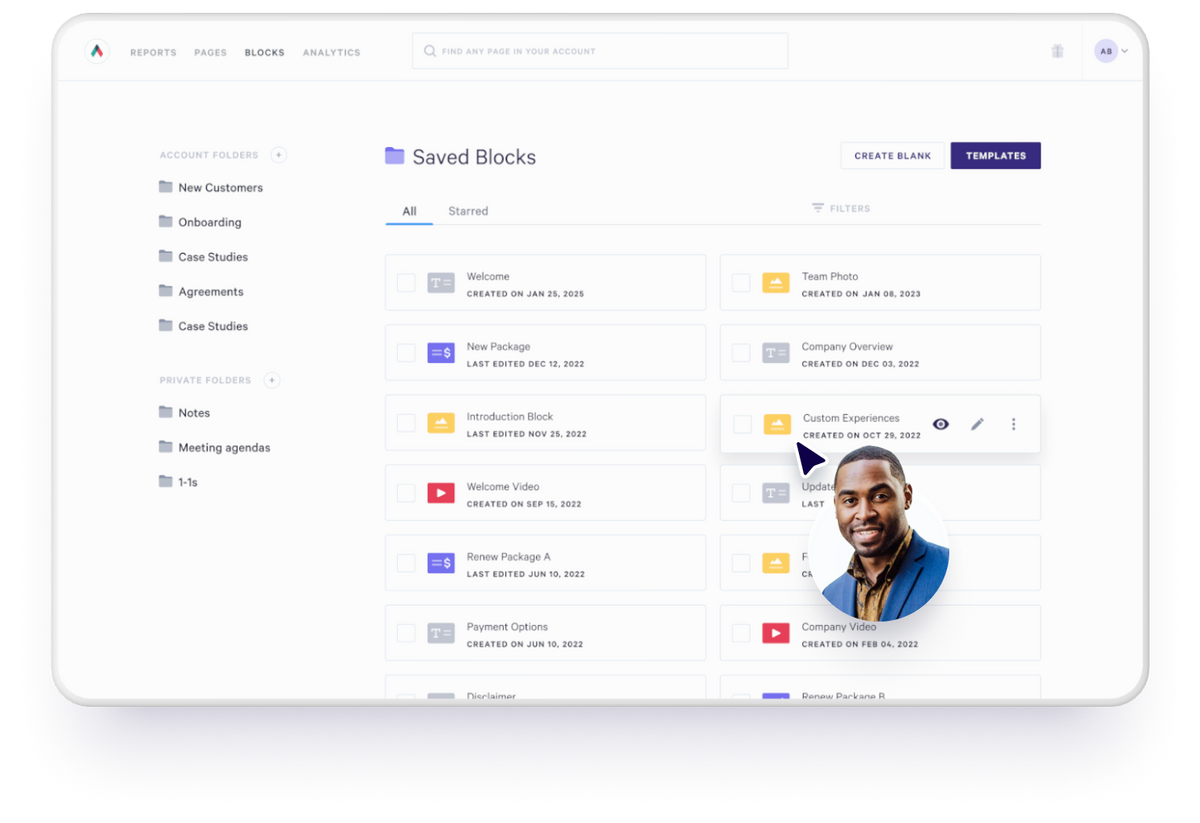
Pricing: Starts at $35/user/month (Business plan), with Enterprise pricing available for larger teams.
Quirky perk: Qwilr makes PDFs look like they belong in a history museum.
2. Seismic – Best for enterprise content armies

If sales content management were a battlefield, Seismic would be the tank. It’s not just a library, it’s a full command center. Seismic combines governance, automation, AI-driven recommendations, and detailed analytics to keep sprawling sales teams aligned and compliant. Enterprises lean on it to ensure that thousands of reps across regions and business units always have the most up-to-date, compliant content at their fingertips.
But with great power comes… a steep learning curve. Implementing Seismic is a serious project, not a plug-and-play tool.
Suited for: Enterprises with thousands of reps, strict compliance, and deep pockets.
Highlights:
- Enterprise-level governance and version control: Ensure only the latest, compliant content is in circulation, with strict access controls for large teams.
- AI-powered “next best content” recommendations: Surface the most relevant asset for each selling scenario, so reps know exactly what to send next.
- Engagement analytics: Track how content is used, who interacts with it, and how buyers engage across different touchpoints.
- Integrations with Salesforce, Microsoft, Oracle, Adobe, and more: Fit seamlessly into the enterprise tech stack without disrupting workflows.
Pricing: Not public—expect Enterprise-level $$$ (translation: your CFO will need a stiff drink).
Quirky perk: It’s the closest thing to a military-grade content arsenal.
3. Highspot – Best for sales enablement-first teams

Highspot positions itself as more than a content hub: it’s an enablement platform. The idea is simple: it’s not enough for reps to have content; they need to know how to use it in real selling situations. Highspot delivers on that by pairing content management with training, playbooks, and guided selling tools. It’s particularly popular with teams that want a single platform for content, enablement, and analytics, rather than stitching together multiple tools.
For revenue leaders, the draw is Highspot’s ability to connect content usage directly to business outcomes like deal velocity and closed revenue.
Suited for: Teams that want enablement + content + analytics all in one place.
Highlights:
- Smart content search with AI-powered recommendations: Quickly surface the most relevant content so reps never waste time digging through folders.
- Playbooks and training modules built right in: Equip reps with guided selling steps and learning resources alongside the content they use every day.
- Analytics that connect content usage directly to closed revenue: Tie collateral performance directly to pipeline impact and deal outcomes.
- Integrates with Salesforce, Outreach, and more: Plug into the tools sales teams already rely on, reducing friction and context-switching.
Pricing: Starts at $600/user/year, with enterprise plans scaling up.
Quirky perk: Like a library where every book comes with Cliff Notes.
4. Showpad – Best for sales training
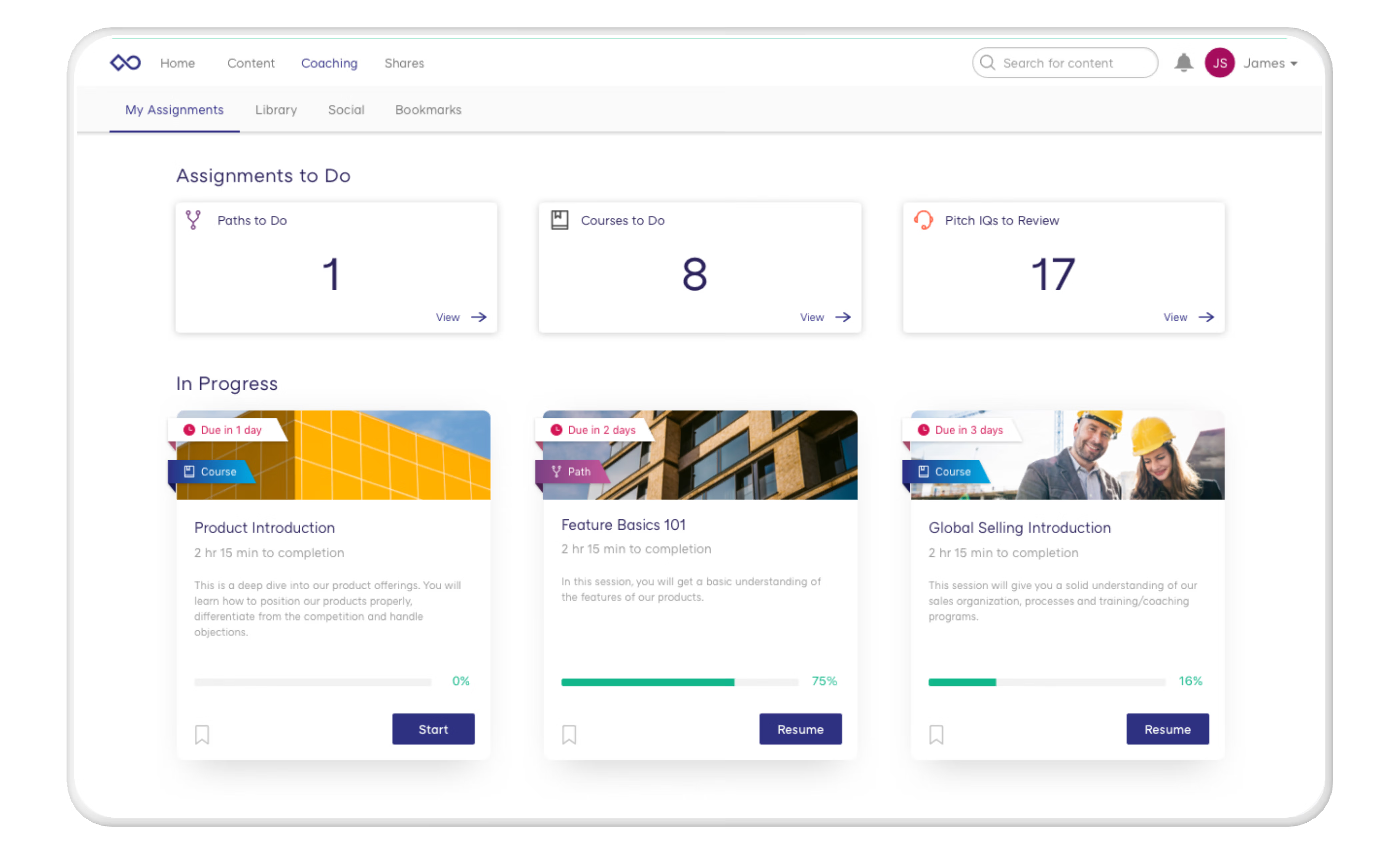
Showpad is where content management meets sales coaching. While it offers the standard centralized library and analytics you’d expect from an SCM platform, its real strength lies in enablement: onboarding, coaching, and training modules that help reps ramp faster and stay sharp. That makes it especially appealing for fast-growing sales orgs juggling both content chaos and the need to upskill new hires quickly.
Think of it as a two-in-one system—part content command center, part digital sales coach—designed to keep teams aligned and educated.
Suited for: Sales orgs that want SCM plus robust onboarding tools.
Highlights:
- Centralized hub for all sales and marketing content: Keep every asset in one organized place so reps and marketers always work from the same playbook.
- Sales coaching + onboarding modules: Help new hires ramp quickly and support ongoing skill development directly within the platform.
- Engagement analytics to measure impact: See how buyers interact with content and understand which assets influence deals the most.
- CRM integrations (Salesforce, HubSpot, Microsoft): Sync seamlessly with your existing systems to streamline workflows and reporting.
Pricing: $420–$600/user/year, depending on features.
Quirky perk: It’s SCM with a built-in sales coach whispering in your ear.
5. ClearSlide – Best for live selling

ClearSlide started life as a sales engagement platform, and that DNA still shows. Unlike traditional SCM tools that stop at storing and sharing, ClearSlide shines in live selling scenarios. Think virtual meetings, pitches, and demos! Its standout feature is real-time engagement tracking, so reps know exactly when prospects are paying attention (or mentally checking their inbox).
That blend of content management and live engagement analytics makes it especially useful for sales teams that spend most of their time presenting rather than just sending decks and proposals.
Suited for: Sales teams who live on calls and want data on buyer attention.
Highlights:
- Centralized library with engagement tracking: Store and share sales content while monitoring how prospects interact with it.
- Live presentation tracking: See, in real time, when your prospect is paying attention - or when their focus drifts elsewhere.
- CRM integrations (Salesforce, Dynamics, etc.): Connect with core sales systems to keep data and activity aligned.
Pricing: Starts at $35/user/month.
Quirky perk: It’s SCM with a built-in “prospect attention meter.”
6. Paperflite – Best for content & marketing alignment
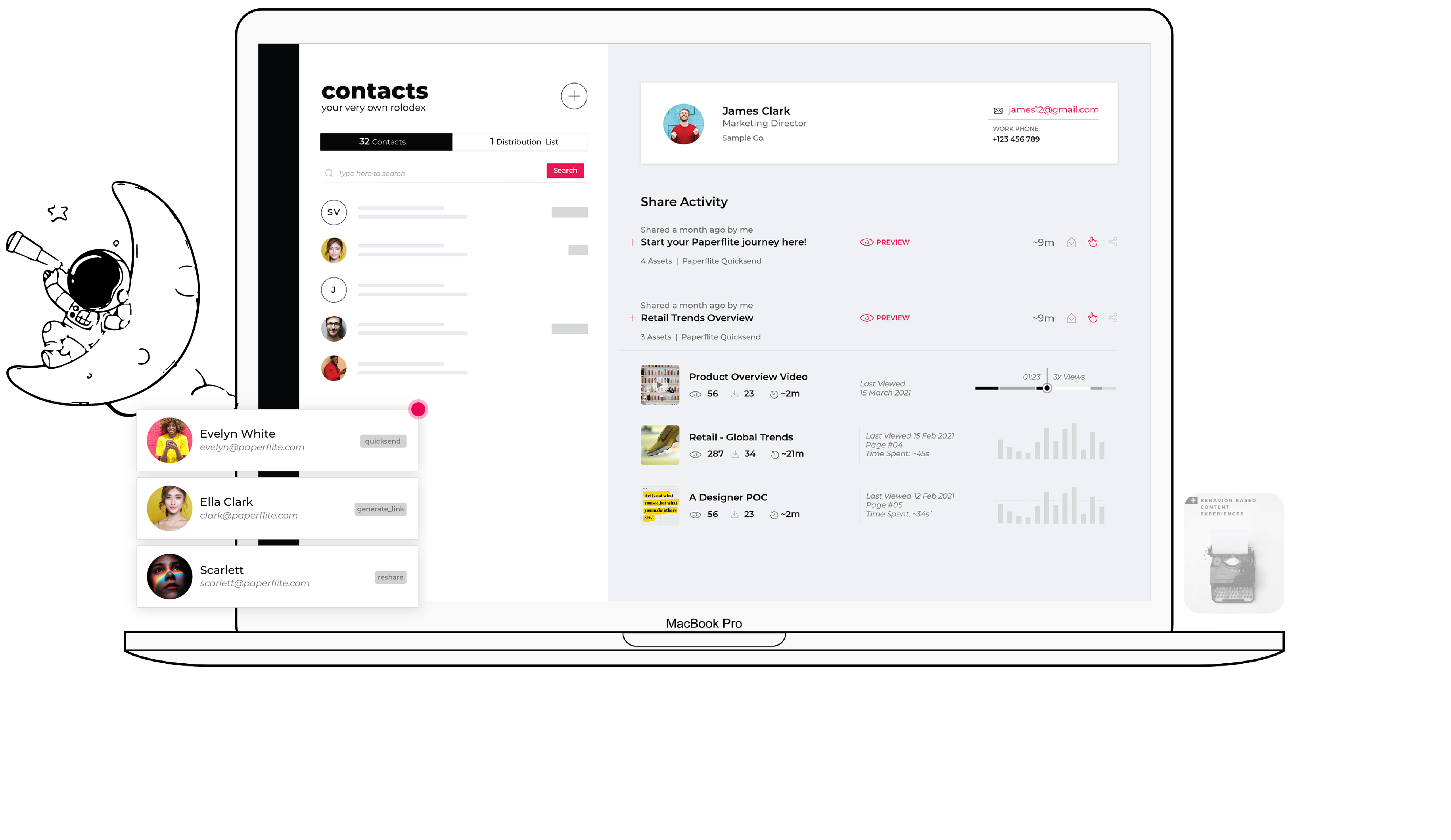
Paperflite brings a heavy dose of design polish to sales content management.
Instead of the usual file-folder feel, it delivers a Netflix-style experience: slick playlists, curated collections, and personalized hubs that make browsing content intuitive (and even fun). But it’s not just about looks: Paperflite also bridges the long-standing gap between marketing and sales.
Marketing can showcase content in beautifully packaged hubs, while sales gets analytics down to which sections prospects actually engaged with. The result? Both sides are finally speaking the same content language.
Suited for: Teams that want marketing and sales perfectly aligned.
Highlights:
- Gorgeous UI with collections and curated playlists: Present content in a sleek, Netflix-style interface that makes browsing intuitive and engaging.
- Analytics down to section-level engagement: Track not just whether content was viewed, but which parts held a prospect’s attention.
- Integrations with Salesforce, HubSpot, Outlook, Gmail: Slot neatly into the sales and marketing tools your team already uses every day.
Pricing: Starts at $40/user/month.
Quirky perk: Content binge-watching is officially a thing.
7. DocSend (by Dropbox) – Best for simple, trackable sharing
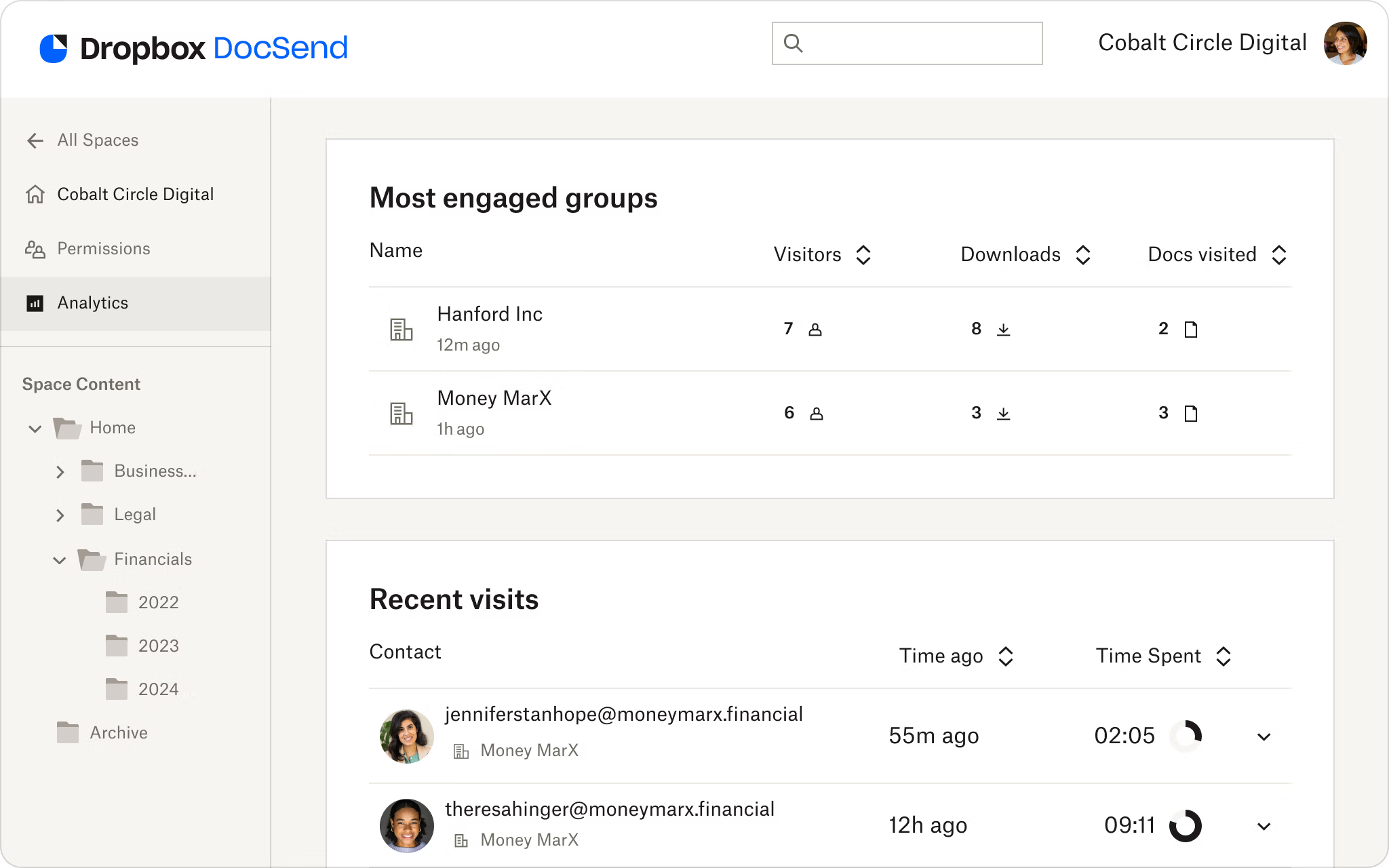
DocSend keeps things refreshingly simple. Instead of building a massive content management ecosystem, it focuses on one thing and does it well: secure, trackable document sharing.
Upload your deck or proposal, generate a link, and instantly see who opened it, how long they spent on each page, and whether they forwarded it. That makes it especially appealing for startups and SMBs that don’t need enterprise-grade governance, just clean version control and visibility without endless email attachments. Think of it as SCM’s lightweight, scrappy cousin.
Suited for: Startups and SMBs that want lightweight, trackable content sharing.
Highlights:
- Trackable, secure links for documents: Share files via unique links and see exactly who opened them, when, and for how long.
- Version control without endless attachments: Keep everyone working from the latest version without clogging inboxes with updated files.
- Access permissions: Control who can view, download, or forward content - so the wrong prospect never gets the wrong file.
Pricing: Starts at $10/user/month (Personal) and scales to $45/user/month (Advanced).
Quirky perk: Perfect for “move fast, break things” sales teams.
8. Guru – Best for knowledge & content in one
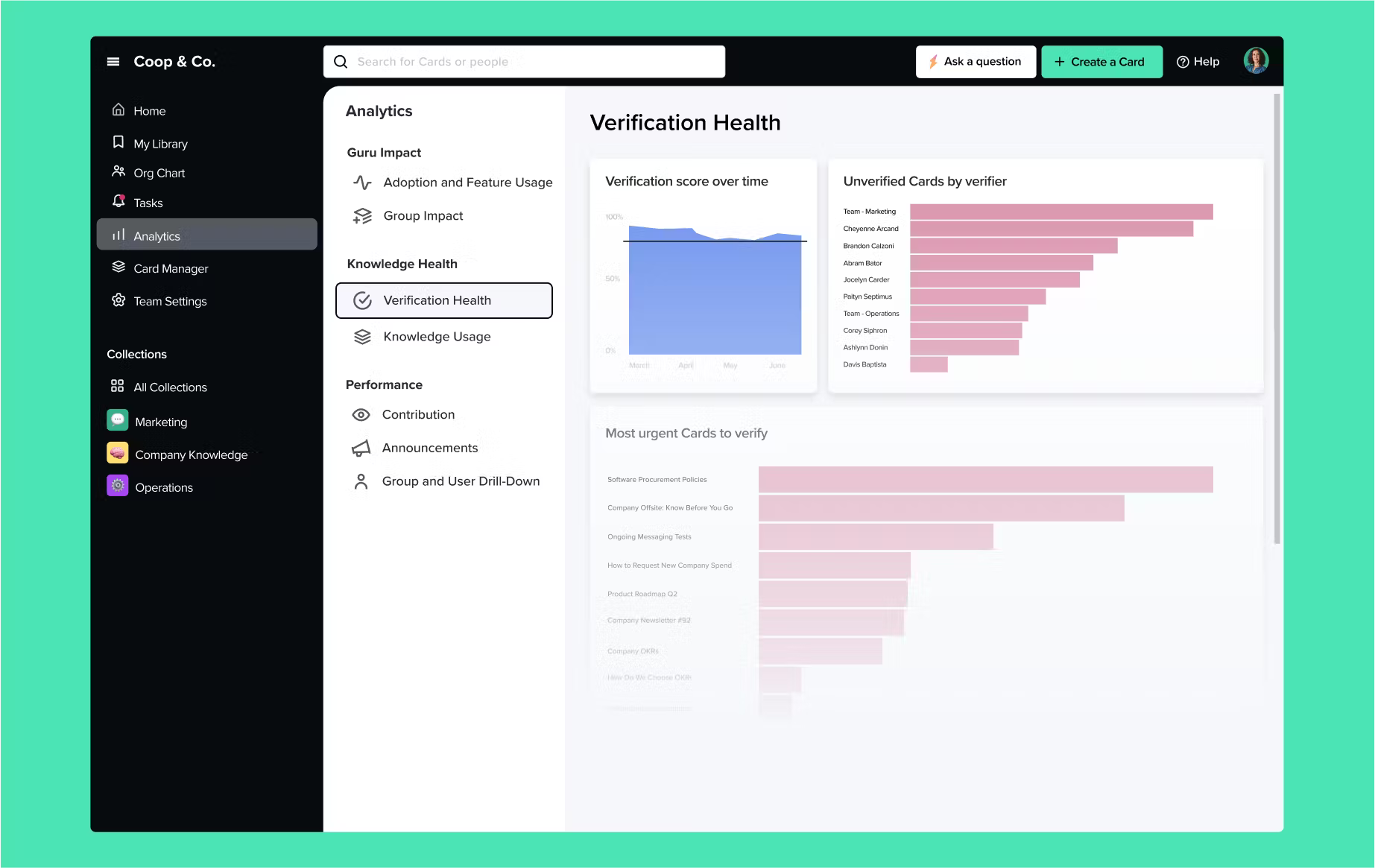
Guru isn’t just for storing decks and case studies; it’s part content hub, part knowledge base. That dual focus makes it ideal for teams who waste time hunting for answers to basic questions (“Where’s the pricing sheet?” or “What’s our refund policy?”).
With its card-based system, browser extension, and AI-driven suggestions, Guru puts both sales collateral and internal know-how at reps’ fingertips, no matter where they’re working. The result: less context-switching, faster responses, and fewer frantic Slack pings to the enablement team.
Suited for: Teams that need answers and sales content in one searchable place.
Highlights:
- Card-based knowledge and content hub: Organize key documents, FAQs, and sales collateral into simple, easy-to-digest cards.
- Browser extension for instant access anywhere: Surface the right content directly in your workflow - whether you’re in email, CRM, or Slack.
- AI suggestions for relevant content: Let the system nudge reps toward the materials most likely to help them in the moment.
- Analytics on content usage: Track which pieces of knowledge and collateral are actually being used, and by whom.
Pricing: Starts at $12/user/month, scaling to $25/user/month (Enterprise).
Quirky perk: The closest thing to giving your team a shared brain.
9. Bloomfire – Best for knowledge-first teams
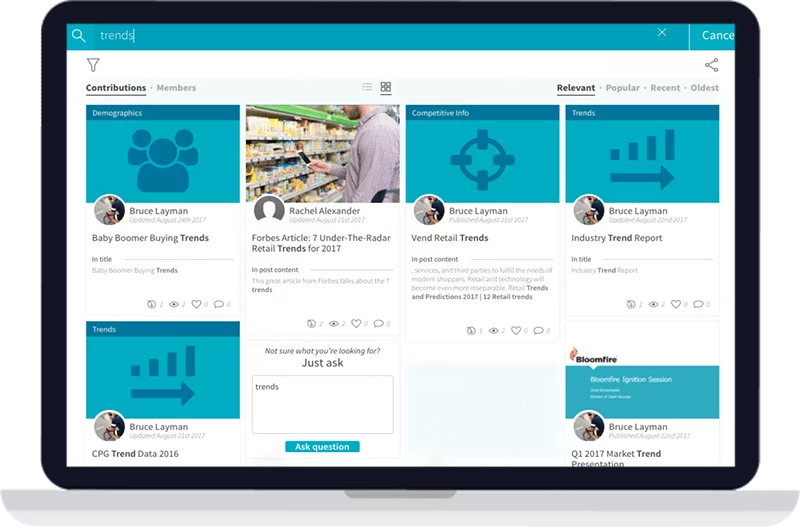
Bloomfire takes a knowledge-first approach to sales content management. Instead of focusing on polished proposals or live selling tools, it’s designed to eliminate internal confusion by centralizing everything your team needs to know: sales decks, FAQs, product documentation, and more.
With smart search, built-in Q&A, and collaboration features, it doubles as both a knowledge management platform and a sales content hub. For organizations where internal clarity is just as important as external messaging, Bloomfire keeps everyone on the same page (literally).
Suited for: Teams where internal documentation is as critical as external sales decks.
Highlights:
- Centralized knowledge + content hub: Store sales collateral, internal docs, and FAQs in a single, searchable platform.
- Smart search across all documents: Quickly locate answers (even within slide decks, PDFs, or long-form documents) using full-text and semantic search.
- Built-in Q&A and collaboration: Encourage peer-to-peer knowledge sharing by letting team members ask questions and crowdsource answers directly in the platform.
Pricing: $25–$50/user/month, depending on features.
Quirky perk: It’s like Slack, SharePoint, and Google Drive had a tidy, knowledge-sharing baby.
10. Bigtincan – Best for mobile-first sales teams
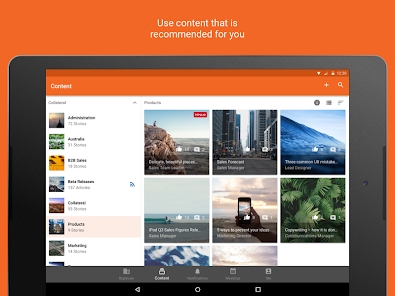
Bigtincan is built with field reps in mind. Whether it’s pharma reps walking into clinics, medtech teams prepping for demos, or manufacturing salespeople on-site with customers, its mobile-first experience is where it shines.
Unlike clunky enterprise software, Bigtincan’s app feels consumer-grade: fast, intuitive, and designed for on-the-go use. Beyond sleek mobility, it also brings AI-driven recommendations, training modules, and CRM integrations to keep reps productive no matter where they are. For sales orgs that live outside the office, it’s one of the most practical SCM options out there.
Suited for: Mobile-heavy sales orgs.
Highlights:
- Mobile-first content hub: Access sales content anytime, anywhere, designed specifically for field reps on smartphones and tablets.
- AI-powered recommendations: Receive intelligent suggestions for the most relevant content to share with prospects in real time.
- Training + coaching modules: Keep reps up to date with embedded learning and skill development tools directly within the platform.
- CRM integrations: Seamlessly connect with Salesforce, HubSpot, or other CRMs to keep content and sales activity in sync.
Pricing: Starts at $50/user/month.
Quirky perk: The mobile app feels like a consumer-grade product, not clunky enterprise software.
11. Mediafly – Best for revenue enablement
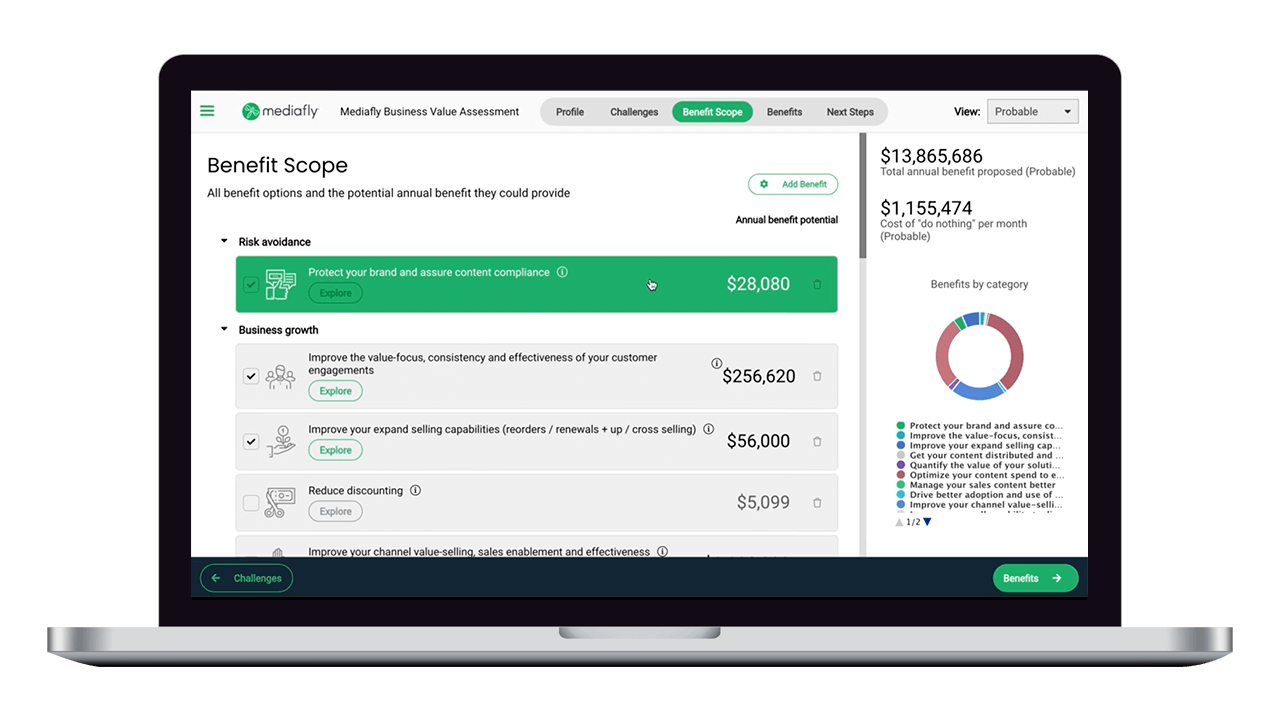
Mediafly goes beyond traditional sales content management by branding itself as a revenue enablement platform. In practice, that means it combines a content hub with forecasting, coaching, and analytics, giving sales leaders visibility not just into what content is used, but how it connects directly to revenue outcomes.
Its mix of engagement data, readiness tools, and revenue intelligence makes it a strong fit for enterprises that want more than just content organization; they want strategic insights that tie enablement to the bottom line.
Suited for: Leaders who want SCM data tied directly to revenue.
Highlights:
- Content hub + engagement analytics: Store all sales materials in one place while tracking how prospects interact with each piece.
- Coaching + readiness tools: Support reps with built-in training and performance insights to keep teams deal-ready.
- Revenue intelligence baked in: Connect content usage directly to pipeline and revenue metrics for data-driven decisions.
- AI-driven content recommendations: Automatically surface the most relevant assets for each selling scenario, helping reps act faster.
Pricing: Custom, but expect Enterprise-tier pricing.
Quirky perk: It’s like buying a Ferrari when you only need an Uber.
Choosing the Right Tool: A Quick Guide
To save you endless swiping through features, here’s a quick cheat sheet matching the right tool to the right role, whether you’re building interactive proposals, training new reps, or tracking engagement on live calls.
| Need / Role | Best Fit |
|---|---|
Interactive, trackable proposals + payments | Qwilr |
Enterprise-scale governance + AI recommendations | Seismic |
Enablement-first content + training | Highspot, Showpad |
Live sales calls with insight | ClearSlide |
Visual content experience + analytics | Paperflite |
Lightweight link-based sharing | DocSend |
Content + internal knowledge base | Guru, Bloomfire |
Mobile field reps enablement | Bigtincan |
Full-stack revenue intelligence + content | Mediafly |
Before you whip out the credit card, ask yourself:
- Team size? Seismic = thousands. DocSend = scrappy startups.
- Need training too? Go Highspot, Showpad, or Bigtincan.
- Visual storytelling? Qwilr or Paperflite.
- Budget-friendly? DocSend or Guru.
- Want content to actually sell, not just sit? Qwilr, hands down.
Don’t just store content, make it SELL
SCM isn’t about prettier folders. It’s about giving reps content that drives revenue. Whether that’s enterprise governance (Seismic), mobile-first agility (Bigtincan), or binge-worthy content hubs (Paperflite), the right tool depends on your team’s needs.
But if you want content that doesn’t just sit there - but closes deals for you - Qwilr is your best bet.
Start your free trial of Qwilr today and turn your static sales docs into interactive, trackable, revenue-generating experiences.
FAQs
How is SCM different from a shared drive like Google Drive or SharePoint?
Shared drives are static storage solutions. SCM platforms go further—they add search, tagging, version control, analytics, guided selling tools, and CRM integrations. In other words, SCM isn’t just about storing files; it’s about making content actionable in the sales process.
What’s the biggest pitfall when choosing SCM software?
Going too big or too small. Enterprise platforms like Seismic or Mediafly are overkill for a 10-person startup, while lightweight tools like DocSend won’t cut it for a 1,000-rep org with compliance needs.
About the author

Brendan Connaughton|Head of Growth Marketing
Brendan heads up growth marketing and demand generation at Qwilr, overseeing performance marketing, SEO, and lifecycle initiatives. Brendan has been instrumental in developing go-to-market functions for a number of high-growth startups and challenger brands.
